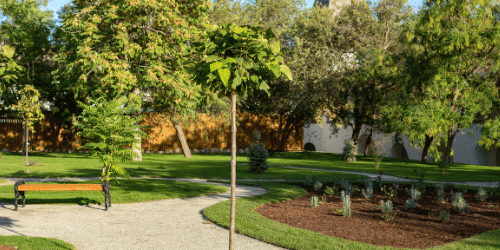A well-designed landscape not only enhances the beauty of your property but also plays a crucial role in supporting local wildlife. By creating a Wildlife Friendly Landscape , you can attract birds, butterflies, and other beneficial creatures to your garden. In this blog post, we’ll explore practical tips and strategies for transforming your outdoor space into a haven for wildlife. Whether you’re a seasoned gardener or a beginner, these insights will help you make a positive impact on your local ecosystem.
Creating a wildlife-friendly landscape involves thoughtful planning, plant selection, and habitat creation. By incorporating native plants, providing food sources, and offering shelter, you can encourage birds and butterflies to thrive in your backyard.
Choosing Native Plants
The Importance of Native Plants
Native plants play a crucial role in supporting local wildlife by offering food and shelter to native insects, birds, and other animals that have evolved alongside them. By opting for native species in your landscaping choices, you actively contribute to the health and balance of your ecosystem. These plants are well-adapted to the local climate and soil conditions, requiring less maintenance and resources compared to non-native alternatives. Additionally, they promote biodiversity by providing habitats for a variety of species, thus enhancing the resilience of natural communities. Choosing native plants is a sustainable practice that benefits both wildlife and the environment as a whole.
Selecting the Right Plants
Enhance biodiversity in your garden by selecting a diverse range of plants that attract various species of wildlife. Opt for plants that bloom at different times throughout the year, ensuring a continuous supply of food sources for local wildlife. Incorporate host plants like milkweed for butterfly larvae, supporting specific species such as monarch butterflies. This approach not only enriches the ecosystem by providing essential resources but also contributes to the overall health and resilience of the natural environment. By cultivating a garden with diverse plant species and thoughtful selection, you create a welcoming habitat that supports a wide array of wildlife throughout the seasons.
Creating Plant Communities
To create microhabitats in your garden, group plants based on their water and sunlight needs. For sunny areas, plant species like coneflowers, black-eyed Susans, and native grasses that thrive in full sun. This creates a vibrant sunny meadow that attracts pollinators and adds color to your landscape. In shaded spots, opt for understory plants such as ferns and wild ginger, which flourish in low light conditions. By designing these distinct microhabitats, you optimize plant health and encourage biodiversity, providing suitable environments for various wildlife species to thrive in your garden.
Providing Food and Water
Bird Feeders and Baths
Enhance your garden’s appeal to birds by installing bird feeders stocked with a variety of seeds, suet, and mealworms, which cater to different bird species’ dietary preferences. Additionally, provide shallow bird baths for drinking and bathing, ensuring they are regularly cleaned and filled with fresh water to attract birds seeking hydration and grooming opportunities. These additions not only support bird populations but also add activity and vitality to your outdoor space, fostering a welcoming environment for avian visitors year-round.
Butterfly Nectar Sources
Butterfly Bush (Buddleja) is renowned for its ability to attract butterflies with its abundant nectar, making it a favorite in butterfly gardens. Lantana is another excellent choice as it attracts both butterflies and hummingbirds with its vibrant blooms and sweet nectar. Zinnias, known for their colorful flowers, also provide plentiful nectar, further enriching the garden’s appeal to butterflies. These plants not only beautify the landscape but also serve as essential food sources, supporting pollinators and enhancing biodiversity in your garden.
Native Fruit-Bearing Trees and Shrubs
Planting fruit-bearing trees such as serviceberry, dogwood, and hawthorn is beneficial for attracting birds year-round. These trees produce fruits that birds rely on for food, offering sustenance especially during colder months when natural food sources may be scarce. By incorporating these species into your landscape, you create a welcoming habitat that supports local bird populations and enhances the overall biodiversity of your garden.
Creating Shelter and Nesting Sites
Birdhouses and Nest Boxes
When placing birdhouses, vary their heights to accommodate different bird species’ preferences. Mounting them at different levels helps attract a diverse range of birds, from ground-dwelling species to those that prefer higher perches. Use natural materials such as wood or gourds for constructing birdhouses, as these materials provide insulation and mimic natural nesting environments. By strategically placing and constructing birdhouses, you create inviting habitats that support nesting and breeding activities, contributing to the conservation of local bird populations.
Butterfly Host Plants
Milkweed is crucial for monarch butterflies as it serves as their primary food source and a critical habitat for their lifecycle. Parsley and dill are also important for attracting swallowtail butterflies, providing essential nectar and serving as host plants for their larvae. Including these plants in your garden not only supports the lifecycle of these butterflies but also enhances biodiversity and promotes a thriving ecosystem in your outdoor space.
Brush Piles and Rock Walls
Creating brush piles using fallen branches and rocks is an excellent way to provide hiding spots and shelter for small animals in your garden or natural area. These piles offer refuge for creatures like insects, reptiles, and small mammals, helping them evade predators and find protection from harsh weather conditions. By incorporating brush piles into your landscape, you enhance biodiversity and create a more hospitable environment that supports a variety of wildlife species. It’s a simple yet effective method to encourage the presence of diverse fauna and promote ecological balance in your surroundings.
Managing Your Landscape Sustainably
Reduce Chemical Use
Minimizing pesticide and herbicide use is crucial for protecting wildlife and promoting a healthy ecosystem. Pesticides and herbicides can harm beneficial insects, birds, mammals, and other wildlife directly or indirectly through contaminated food sources. By reducing their use, you help preserve biodiversity and create a safer environment for wildlife to thrive. Implementing alternative pest management strategies such as integrated pest management (IPM), planting native species that are naturally resistant to pests, and practicing organic gardening methods can effectively control pests while minimizing harm to wildlife. This approach supports a balanced ecosystem where wildlife can flourish alongside plants and crops.
Composting and Mulching
Composting enriches the soil by breaking down organic matter into nutrient-rich humus, which improves soil structure and fertility. It also reduces the need for chemical fertilizers, contributing to environmental sustainability. Mulching, on the other hand, retains moisture in the soil, suppresses weeds, and moderates soil temperature. Additionally, mulch provides habitat for beneficial insects like earthworms and beetles, which contribute to soil health through their activities. Together, composting and mulching create a healthier environment for plants, enhance biodiversity in the garden, and support sustainable gardening practices.
Encourage Biodiversity
Planting a diverse mix of trees, shrubs, perennials, and annuals is crucial for supporting a wide range of wildlife in your garden. Trees such as oak and maple provide food and shelter for birds and small mammals, while shrubs like elderberry and dogwood offer berries that attract birds and insects. Perennials such as coneflowers and milkweed attract butterflies and bees with their nectar-rich flowers, supporting pollination. Annual flowers like sunflowers and zinnias provide additional food sources and nesting materials for birds. By creating a varied landscape with different plant heights, bloom times, and habitats, you can maximize biodiversity and create a thriving ecosystem in your garden.
Answering Common Questions
Q1 How can I attract hummingbirds?
A1 Plant tubular flowers like bee balm, salvia, and trumpet vine.
Q2 What about squirrels and rabbits?
A2 Provide squirrel-proof bird feeders and rabbit-resistant plants.
Q3 Can I have a wildlife-friendly lawn?
A3 Yes! Mow less frequently, leave some wild areas, and avoid chemical treatments.
The Impact of Urbanization on Wildlife
Urban development affects wildlife habitats. By creating wildlife-friendly landscapes, we mitigate some of these negative impacts and promote biodiversity.
Seeking Expert Advice
Consult local gardening experts or wildlife organizations for personalized guidance. They can recommend specific plants, habitat enhancements, and conservation practices. Remember, your wildlife-friendly landscape isn’t just about aesthetics—it’s an investment in the health of your local ecosystem. Enjoy the beauty of birds and butterflies while contributing to a more sustainable environment.
Conclusion Cultivating a Harmonious Haven for Nature
As the sun dips below the horizon, casting a warm glow upon your garden, you stand amidst a tapestry of life. Your wildlife-friendly landscape isn’t merely an arrangement of plants and stones; it’s a symphony—an intricate composition where every note matters.
Each native plant whispers stories of resilience, adaptation, and coexistence. Their roots intertwine, forming an underground network—a botanical internet—where information flows silently. The cardinal flower nods to the bee, and the oak tree shelters generations of squirrels. You’ve become a steward of this ancient dialogue. As seasons change, your landscape morphs—a kaleidoscope of colors and textures. The milkweed, with its fuzzy leaves, cradles monarch caterpillars. The coneflower, petals outstretched, invites pollinators to sip nectar. And the grasses sway, their seed heads promising renewal.
At dawn, the air vibrates with song. The robin, perched on a branch, greets the day. The blue jay, bold and raucous, announces its presence. And the hummingbird, a fleeting jewel, hovers near the trumpet vine, sipping sweetness. Your birdhouses—miniature mansions—witness courtship, nest-building, and fledgling flights. The chickadee inspects a cozy cavity, while the wren scolds intruders. You watch, a silent audience, as life unfolds. The butterfly emerges—a miracle in miniature. Its wings, delicate as gossamer, carry stories of metamorphosis. The monarch, guided by celestial maps, embarks on an epic journey. The swallowtail, with its iridescent markings, flits from flower to flower.
Visit Us At Tailor Made
For more information and personalized guidance, visit us at Tailor Made Contracting is here to provide you with exceptional landscape design services that transform your outdoor space into a work of art. Whether you’re dreaming of a lush garden, a tranquil patio, or a vibrant play area, we’ll bring your vision to life. Contact us today and let’s create something extraordinary together!







